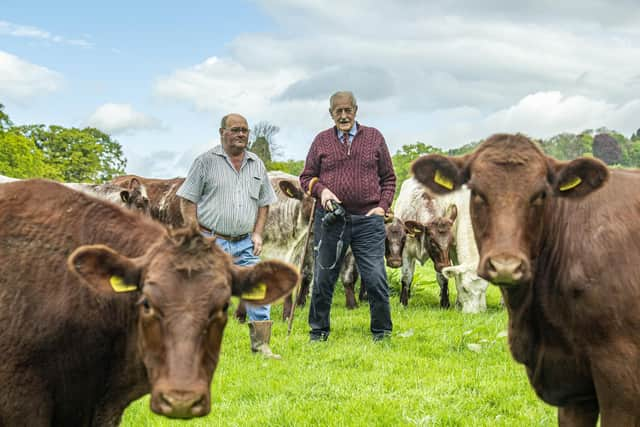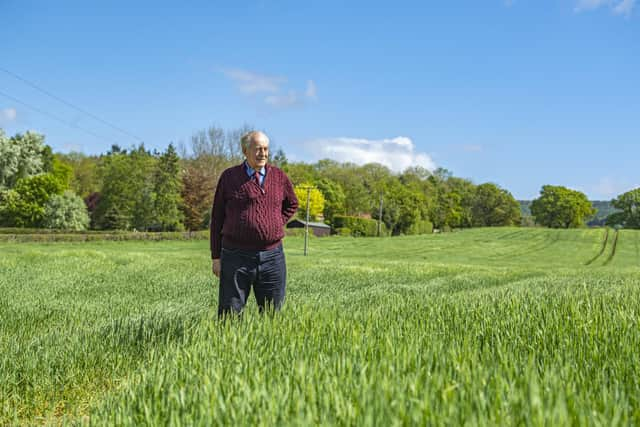Farm of the Week: Beef Shorthorn herd that has dominated Yorkshire cattle breeding since 1909
Gerald Turton’s Upsall Shorthorns, based at Park House Farm and part of the 1,000-acre Upsall Castle Farms near Thirsk, is one of the breed’s most respected herds, started by his great uncle Sir Edmund Turton in 1909.
Gerald said he and his stockman George McCulloch, who has been with him for the past decade, concentrate their breeding policy on producing the traditional Shorthorn to the highest health status.
Advertisement
Hide AdAdvertisement
Hide Ad“Everyone is entitled to breed the type of cattle they wish and ours is the traditional Shorthorn. We operate a closed herd. We haven’t bought in any bulls for quite a while, using our home-reared bulls, of which we have four working at present, because we know what’s ‘in the tin’. We also use semen from Canadian and Australian bulls.


“Our reputation has come because we have stuck to our principles of producing Shorthorns the way they are meant to be – milky, healthy, thrifty and docile – and because we have maintained our high health status, which has just been confirmed once again through the SRUC’s Premium Cattle Health Scheme. We continue to see strong demand for both our male and female Shorthorns.”
Gerald said the selection process practiced, in which cattle are sold to others or retained in the herd, includes individual analysis of each animal, either through figures or breed experience.
“I have always gone for figures. We weigh them, we scan them and look at such as calving ease as well as all other attributes that you are looking for in a working animal. Figures are a tool we use, but those people who say it is all in the figures are talking nonsense.
Advertisement
Hide AdAdvertisement
Hide Ad“They are however quite useful as an indication of either where an animal may be short in a certain area or as a way of opening your eyes that may have been blind to something.”


Producing stock that has gone on to work well for others has always been a source of great pride to Gerald and to George, and in so doing maintains the herd’s longevity.
Gerald said the Upsall Shorthorns have been responsible for several new herds starting in recent times and many in the past.
“We try to cover everything that our buyers are looking for in a correct animal of the breed and most people are quite happy to buy from us.
Advertisement
Hide AdAdvertisement
Hide Ad“We have always kept the Beef Shorthorn flag flying. When the breed had gone through a difficult time, some years ago, we were one of only two pedigree breeders left in England. We held a sale on the farm in those days, every four years, and as a result we were instrumental in assisting with the start-up of at least eight new herds.
“In August last year the sale we held at Skipton livestock market saw three new herds starting up, all within 20 miles of Upsall.”
Gerald believes that the breed’s and the Upsall herd’s increasing popularity for new start-ups is not just down to its correctness but its ability to thrive off grassland that requires little in the way of additional work or cost. Shorthorns and other native breeds are being backed by the Government through its environmental campaigns in certain areas, which has an impact.
Shorthorns are a low-cost breed because they can fend for themselves off grass.”
Advertisement
Hide AdAdvertisement
Hide AdGeorge McCulloch believes the success of the herd is down to producing what he said is a consistently happy medium.
“Big is not beautiful. We look for a bit of size and a bit of power in our bulls, but it needs to be a good balance. We’re not wanting our stock to be too small or too big.
“In Great Britain there are many different types of good and marginal land that all grazes differently for cattle. It is important that you adapt your cattle to suit the ground condition they are going to graze. There is a lot of land that cannot handle big, heavy cattle.”
George said the bull policy at Park House carries on being very successful. “We have bulls that go to Stirling for the pedigree bull sales and in February this year we had one at 25,000 guineas. We also sell bulls privately and females are sold at Skipton. As far as bulls are concerned I was always told that when you put your bull out with the cows he should be the dominating factor and should be the first animal you see. He’s the boss. We have four like that amongst our herd that runs to around 250 cattle.
Advertisement
Hide AdAdvertisement
Hide Ad“We are primarily natural bulling on around three-quarters of the 90 cows and heifers. The way we bring new blood into the herd is by purchasing semen that we believe is suitable by checking out the characteristics we are looking for.
“At present we are using semen from a Canadian bull Crooked Post Driver 29D that we have used for the past four years and from which we now have two homebred sons that we are using as stock bulls; and semen from an Australian bull Royala Rockstar. We have just started using him.”
Gerald said his first move when returning to Upsall was to change the herd to polled, buying from a breeder who was in the lace trade in Nottingham, and that he vividly recalls the bull sales in Perth, travelling over the Firth of Forth by ferry and how the breed eventually went on the slide for many years.
“It was before the Forth Road Bridge was built and a time when the bull sales were international with buyers from South Africa, Argentina, America and Australia investing a phenomenal amount in stock. It is also how the breed lost its way and became too small and short legged.”
Advertisement
Hide AdAdvertisement
Hide AdUpsall Shorthorns haven’t been shown since 2018, but in this the Beef Shorthorn Bicentennial year, that sees a World Conference Tour starting on July 7 2022 and taking in the Great Yorkshire Show, Gerald said they will be back in Harrogate.
“We will have a team there, two males and two females.”
Comment Guidelines
National World encourages reader discussion on our stories. User feedback, insights and back-and-forth exchanges add a rich layer of context to reporting. Please review our Community Guidelines before commenting.
